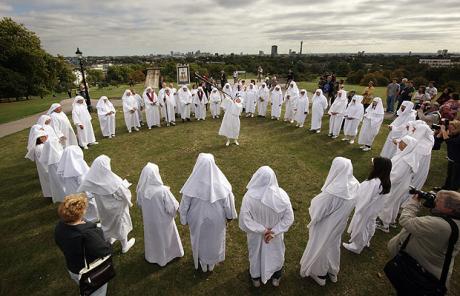| |
Druidry recognised as religion in Britain for first time |
|
Source: http://www.telegraph.co.uk/news/newstopics/religion/8036952/Druidry-recognised-as-religion-in-Britain-for-first-time.html
 |
|
The Druid Network has been given charitable status by the Charity Commission for England and Wales, the quango that decides what counts as a genuine faith as well as regulating fundraising bodies.
It guarantees the modern group, set up in 2003, valuable tax breaks but also grants the ancient religion equal status to more mainstream denominations. This could mean that Druids, the priestly caste in Celtic societies across Europe, are categorised separately in official surveys of religious believers.
Supporters say the Charity Commission’s move could also pave the way for other minority faiths to gain charitable status.
Phil Ryder, Chair of Trustees for The Druid Network, said it had taken four years for the group to be recognised by the regulator. “It was a long and at times frustrating process, exacerbated by the fact that the Charity Commissioners had no understanding of our beliefs and practices, and examined us on every aspect of them. Their final decision document runs to 21 pages, showing the extent to which we were questioned in order to finally get the recognition we have long argued for,” he said.
Emma Restall Orr, founder of The Druid Network, added: “The Charity Commission now has a much greater understanding of Pagan, animist, and polytheist religions, so other groups from these minority religions – provided they meet the financial and public benefit criteria for registration as charities - should find registering a much shorter process than the pioneering one we have been through.”
In its assessment of the Druid Network’s application, the Charity Commission accepts that Druids worship nature, in particular the sun and the earth but also believe in the spirits of places such as mountains and rivers as well as “divine guides” such as Brighid and Bran.
The document lists the “commonality of practice” in Druidry, including its eight major festivals each year; rituals at different phases of the moon; rites of passage and gatherings of bards on sacred hills, known as “gorsedd”.
All charities must now demonstrate their benefit to the public, and Druidry was said to qualify since its followers are keen to conserve Britain’s heritage as well as preserve the natural environment.
The document even addresses the claims made by the Romans about Druids committing human sacrifice, but finds “no evidence of any significant detriment or harm” arising from modern beliefs.
It notes that although there are only 350 members of the Druid Network, a BBC report in 2003 claimed as many as 10,000 people followed the ancient faith across the country.
Membership of the Network costs £10 a year but ritual ceremonies such as that marking the summer solstice at Stonehenge are open to all.
From Wikipedia :
A druid was a member of the priestly class in Gaul and possibly other parts of Celtic western Europe during the Iron Age. Following the invasion of Gaul by the Roman Empire, the druids were suppressed by the Roman government from the 1st century CE and disappeared from the written record by the 2nd century, although there may have been later survivals in the British Isles. Very little is currently known about the ancient druids as they left no written accounts about themselves, and other than a few descriptions left by Greek and Roman authors, and in stories created by later mediaeval Irish writers, the accuracy of all of which are disputed, we have no evidence about them. While archaeological evidence has been uncovered pertaining to the religious practices of the Celtic people, "not one single artefact or image has been unearthed that can undoubtedly be connected with the ancient Druids."
The earliest reference to the druids that we know of dates to 200 BCE, although the oldest actual description that we have of them comes from the Roman military general Julius Caesar in his Commentarii de Bello Gallico from the first century BCE, in which he claimed that they were responsible for organising worship and sacrifices, divination and judicial procedure in Gaulish and British society.However, Caesar's claims have been scrutinised by later historians who have noted that his own personal bias would have affected his portrayal of them, thereby indicating that it was somewhat inaccurate. Later Greco-Roman writers also described the druids, including Cicero, Tacitus and Pliny the Elder, each of whose accuracy has similarly been brought into question by historians. The druids then also appear in some of the mediaeval tales from Christianised Ireland like the Táin Bó Cúailnge, where they are largely portrayed as sorcerers who opposed the coming of Christianity.
Various recurring themes emerge in a number of the Greco-Roman accounts of the druids, including that they performed human sacrifice, believed in a form of reincarnation, and that they held a high position in Gaulish society - however, the truth of all of these things have been questioned by historians and archaeologists. Their supposed reverence for various aspects of the natural world, such as the ritual of oak and mistletoe described by Pliny the Elder, has also been associated with animism by certain modern scholars.
The concept of the druids has been continuously used in western Europe since at least the Early Modern period, and has been reinterpreted by various different groups in often radically different ways. In the wake of the Celtic revival during the 18th century, fraternal and Neopagan groups were founded based upon the ideas about the ancient druids, a movement which is known as Neo-druidry.

Submit News/Videos/Links |
Discuss article |
Article Link
|
More unsolved mysteries on Unexplained Mysteries
|


![]()